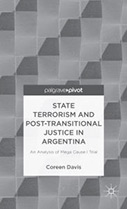State Terrorism and Post-transitional Justice in Argentina: An Analysis of Mega Cause I Trial

Author: Coreen Davis
Publisher: Basingstoke, UK: Palgrave Macmillan, 2013. 95p.
Reviewer: Saskia van Drunen | November 2015
In her book State Terrorism and Post-transitional Justice in Argentina: An Analysis of Mega Cause I Trial, Coreen Davis focuses on the criminal trials that are currently taking place in Argentina against alleged perpetrators of human rights violations committed during the last civil-military dictatorship (1976-1983). She particularly focuses on one of the largest in the recent surge of human rights trials, Mega Cause I, which ended with the condemnation of 16 out of the 18 defendants. All were ex-naval officers that during the dictatorial rule were operating in the clandestine detention centre located in the Navy Petty-Officers School of Mechanics (ESMA) in Buenos Aires. Through a detailed analysis of this trial, Davis seeks to make a contribution by revealing some of the effects of post-transitional justice in Argentina. The study analyses the role of the state and of human rights organisations in the trial; the successes of the trial, but also the difficulties that the prosecution faced during the trial’s proceedings; and how some of these affect the preparation of the successor of Mega Cause I, the even more complex and larger trial Mega Cause II. Moreover, she analyses the trial’s implications for truth, memory, and reconciliation, the three pillars that alongside justice constitute the core of the transitional justice agenda. The book is based on the author’s Master’s Thesis. Data for this research were collected in Buenos Aires in June 2012. The author conducted interviews with seven prominent members of the prosecution of Mega Cause I, did an internship at the Dr. Fernando Ulloa Centre for the Assistance of Victims of Human Rights Abuses (hereafter: Ulloa Centre), and attended human rights trials and demonstrations.
Throughout her book, Davis makes several claims about her contribution to the ongoing discussion about transitional and post-transitional justice. First, she claims to address a gap in the literature on the recent human right trials in Argentina. As she rightly states, most of the information that is available on these trials is published in online blogs, newspaper articles or publications that are more descriptive than analytical. Davis aims to address this gap by providing an in-depth analysis and a better understanding of the Mega Cause I. Davis’s second claim is theoretical. She argues that while most studies on post-transitional justice emphasize the role of foreign courts or national activism in the search for justice, her analysis shows the importance of the state (in this particular case, the Argentine state) in promoting successful judicial action. According to Davis, this actor has remained unexplored in much of the post-transitional literature.
These claims are developed in five chapters. The first chapter introduces the subject of the book and the theoretical debates into which she aims to insert her own work. Chapter 2 focuses on the role of the state and human rights organisations, and specifically evaluates their role in Mega Cause I. Davis does this by analysing four different actors: the Human Rights Secretariat, which acts as a plaintiff in human rights court cases, including Mega Cause I; the Ulloa Centre, founded in 2003 as a branch of the Human Rights Secretariat, and which provides psychological assistance to the victim-witnesses involved in the human rights trials; the Institute Space for Memory (IEM), an autonomous body founded in 2002 with the task of supervising all the memory projects in the city of Buenos Aires; and the Centre for Legal and Social Studies (CELS), a human rights organisation founded in 1979 that has been a leading actor in the trials.
Chapter 3 analyses some of the successes of the trial, as well as the many obstacles that the prosecution encountered in the development of the trial. This chapter offers some interesting insights into the workings of the Argentine judiciary and how certain choices in this particular case lead to a number of challenges for the prosecution. The decision to use the existing judicial system to conduct the trial, rather than a special tribunal or international assistance, was important for the legitimacy of the trials. But it also presented specific dilemmas, for example, the concept of forced disappearance — so important to victims and human rights organisations in Argentina — did not translate into existing legislation. Therefore, defendants could not be prosecuted for forced disappearance but only for other crimes, such as abduction, violation of liberty, torture or the stealing of personal goods. A second important choice that led to a number of complications was the decision of the federal courts of Buenos Aires to accumulate evidence and accuse multiple defendants from the same detention centre together. The intention was to save time, conduct fewer trials and limit the number of times witnesses testify. But this choice also created many difficulties, including: the quantity of defendants, witnesses and lawyers, which made it hard to control and manage the trial, and the fact that the existing space and structure of the legal apparatus were not designed for such large trials.
Chapter 4 looks at the effects of Mega Cause I on three other key issues that are often mentioned in discussions on transitional justice: truth, memory and reconciliation. The chapter argues that Mega Cause I was important for uncovering the truth about the repression in different ways: truth was uncovered through the investigation in the preparatory stage of the trial, as well as through the testimonies and the defendants’ statements during Mega Cause I. The trial also became a venue for the re-construction of memory, particularly for younger generations. According to Davis, the trial ‘allowed for the arguments of both the prosecution and the defence to be publically heard and for individuals within society to form their own opinions’ (p 17). The trial did not, however, effect reconciliation — a predictable outcome, as reconciliation is a highly controversial concept in Argentina and certainly not the primary goal of Argentine human rights organisations, victims and members of the judiciary involved in the pursuit of justice. Finally, chapter 5 provides a summary of the findings and recommendations for future research.
The book is an interesting attempt to contribute to a relatively unexplored dimension of Argentina’s rich recent history of societal, political and judicial attempts to deal with the legacies of human rights violations and dictatorship. As the author herself points out, relatively few academic publications have appeared on the recent human rights trials. In that sense, Davis’s analysis of Mega Cause I, and especially the chapter on the trial itself and the difficulties of conducting such a large trial within the existing Argentine judicial system, is a welcome contribution to our understanding of this recent development in Argentina. The Mega Cause I trial is a good choice for a case study: the fact that it was conducted within the national juridical system and with existing laws, as well as with the active involvement of the national state, already make it a very interesting case to analyse in the light of (post)transitional justice debates. Her observations on the case raise a number of issues that would certainly be worthwhile exploring in more depth. For example, the involvement of the nation-state, both through the judiciary, and through state institutions like the Secretariat for Human Rights acting as plaintiffs in the case, points at the a-typical role that the Argentine state is playing in the search for justice. This is true particularly compared to many other places around the world where the national state is absent and those promoting justice are mostly non-state actors and special tribunals such as the International Criminal Court. It would certainly be interesting to reflect more on the implications of this role for the workings of Argentine democracy. Similarly, the size and complexity of the case, and how it is affecting the national judicial system, raises a challenging question: What are some of the side-effects of the human rights trials for the Argentine judiciary system and how can they be dealt with adequately?
At the same time, while some of these issues and dilemmas are touched upon in the book, Davis’s approach to the subject leaves us wanting more. The author does not always manage to avoid reducing her very complex and dynamic topic to a number of simple points. This is especially true of chapter 4, where Davis analyses some of the impacts of Mega Cause I on truth, memory and reconciliation. Concepts such as memory, truth and reconciliation are introduced without offering a more detailed discussion of the very different meanings that the wide range of social actors involved in the struggles over the recent past in Argentina attribute to them. The chapter would have benefitted from a more solid discussion of the different meanings and interpretations that co-exist in Argentina around these issues. Similarly, in chapter 2, which focuses on the role of the state, Davis does not explain how she conceptualizes the state, nor does she seem to acknowledge the fact that the state is not homogenous, but involves multiple players and parties, an observation that would have given her analysis more depth. The very institutions that she analyses in this chapter illustrate this heterogeneity — the judiciary, the Ulloa Centre, the Secretariat for human rights — are three very different state entities with different mandates and purposes. Even the IEM, a mixed entity in which alongside civil society organisations the state also has a voice, confirms this point. And while the author treats all these entities, she does not reflect on their heterogeneity and its implications for our understanding of the role of the state in post-transitional justice Argentina.
Another weakness of Davis’s book is the thin evidence upon which she bases her analysis. Most of her evidence comes from the seven interviews with prominent members of the prosecution involved in the trial. While the choice to focus on relatively few interviews is understandable given the fact that Davis only had one month to do her research, the conclusions that she draws from these interviews are too broad. Her analysis of the meaning and impact of the trial on truth, memory and reconciliation, for instance, draws almost exclusively on the opinions and ideas of these seven interviewees. Another example is her analysis of the work of the Ulloa Centre, the state institution that works with victim-witnesses. In this chapter, Davis stresses the relevance and importance of the Ulloa centre, a conclusion that is based on her brief internship and two interviews: one with an employee of the Ulloa centre, and another one with an employee of the Secretariat for Human Rights, the institution that founded the Ulloa Centre. Readers are made to wonder what the victim-witnesses themselves think of the institution. Generally, this chapter would have benefitted greatly from a broad contextualisation of the institutions analysed, showing how they are embedded in a larger and extremely diverse movement that is seeking justice.
Nevertheless, despite these flaws, the book offers an interesting read, especially for those who are not so familiar with Argentina and with the human rights trials that are currently taking place in that country. The book provides rich insights into the concrete workings of one of these trials, Mega Cause I, and the many obstacles that the prosecution faced in trying to advance in its quest for justice, and points out some interesting issues on post-transitional justice in Argentina to be explored in future research.
Saskia van Drunen, Consultant at Fair and Sustainable Advisory Services


